Performance Assessment of Portable Optical Particle Spectrometer (POPS)
Abstract
1. Introduction
1.1. Summary of Optical Particle Spectrometer Application
1.2. Portable Optical Particle Spectrometer (POPS)
2. Materials and Methods
3. Results and Discussion
3.1. Counting Efficiency at the Lower Size Range
3.2. Total Concentration Counting Limits
3.3. Size Determination
3.4. Particle Morphology and Refractive Index Effects on POPS And UHSAS
3.5. Laser Temperature Effect on POPS Operation
3.6. POPS Operation under Different RH Environment
4. Field Applications
4.1. POPS and PCASP Inter-Comparison During Aircraft Testing
4.2. TBS Deployment
5. Conclusions
Supplementary Materials
Author Contributions
Funding
Conflicts of Interest
References
- Amaral, S.S.; de Carvalho, J.A.; Costa, M.A.M.; Pinheiro, C. An Overview of Particulate Matter Measurement Instruments. Atmosphere 2015, 6, 1327–1345. [Google Scholar] [CrossRef]
- Lohmann, U.; Feichter, J. Global indirect aerosol effects: A review. Atmos. Chem. Phys. 2005, 5, 715–737. [Google Scholar] [CrossRef]
- Twomey, S. Pollution and Planetary Albedo. Atmos. Environ. 1974, 8, 1251–1256. [Google Scholar] [CrossRef]
- Lee, A.; Hanlon, D.; Sakai, R.; Morris, V.; Demoz, B.; Gadsden, S.A. Development of an Autonomous Unmanned Aerial System for Atmospheric Data Collection and Research. Proc. Spie 2016, 9862, 98620A. [Google Scholar]
- Reineman, B.D.; Lenain, L.; Statom, N.M.; Melville, W.K. Development and Testing of Instrumentation for UAV-Based Flux Measurements within Terrestrial and Marine Atmospheric Boundary Layers. J. Atmos. Ocean. Technol. 2013, 30, 1295–1319. [Google Scholar] [CrossRef]
- Spence, C.; Mengistu, S. Deployment of an unmanned aerial system to assist in mapping an intermittent stream. Hydrol. Process. 2016, 30, 493–500. [Google Scholar] [CrossRef]
- Villa, T.F.; Salimi, F.; Morton, K.; Morawska, L.; Gonzalez, F. Development and Validation of a UAV Based System for Air Pollution Measurements. Sensors 2016, 16, 2202. [Google Scholar] [CrossRef]
- Potter, T.D.; Colman, B.R. Handbook of Weather, Climate, and Water: Atmospheric Chemistry, Hydrology, and Societal Impacts; Wiley-Interscience Hoboken: Hoboken, NJ, USA, 2003; Volume 1. [Google Scholar]
- Wendisch, M.; Brenguier, J.-L. Airborne Measurements for Environmental Research: Methods and Instruments; John Wiley & Sons: New York, NY, USA, 2013. [Google Scholar]
- McMurry, P.H. A review of atmospheric aerosol measurements. Atmos. Environ. 2000, 34, 1959–1999. [Google Scholar] [CrossRef]
- Miles, R.E.H.; Carruthers, A.E.; Reid, J.P. Novel optical techniques for measurements of light extinction, scattering and absorption by single aerosol particles. Laser Photonics Rev. 2011, 5, 534–552. [Google Scholar] [CrossRef]
- Miles, R.E.H.; Rudic, S.; Orr-Ewing, A.J.; Reid, J.P. Sources of Error and Uncertainty in the Use of Cavity Ring Down Spectroscopy to Measure Aerosol Optical Properties. Aerosol Sci. Technol. 2011, 45, 1360–1375. [Google Scholar] [CrossRef]
- Burkart, J.; Steiner, G.; Reischl, G.; Moshammer, H.; Neuberger, M.; Hitzenberger, R. Characterizing the performance of two optical particle counters (Grimm OPC1.108 and OPC1.109) under urban aerosol conditions. J. Aerosol Sci. 2010, 41, 953–962. [Google Scholar] [CrossRef] [PubMed]
- Kupc, A.; Williamson, C.; Wagner, N.L.; Richardson, M.; Brock, C.A. Modification, calibration, and performance of the Ultra-High Sensitivity Aerosol Spectrometer for particle size distribution and volatility measurements during the Atmospheric Tomography Mission (ATom) airborne campaign. Atmos. Meas. Tech. 2018, 11, 369–383. [Google Scholar] [CrossRef]
- Szymanski, W.W.; Nagy, A.; Czitrovszky, A. Optical particle spectrometry—Problems and prospects. J. Quant. Spectrosc. Radiat. Transf. 2009, 110, 918–929. [Google Scholar] [CrossRef]
- Yoo, S.H.; Chae, S.K.; Liu, B.Y.H. Influence of particle refractive index on the lower detection limit of light scattering aerosol counters. Aerosol Sci. Technol. 1996, 25, 1–10. [Google Scholar] [CrossRef][Green Version]
- Cai, Y.; Montague, D.C.; Mooiweer-Bryan, W.; Deshler, T. Performance characteristics of the ultra high sensitivity aerosol spectrometer for particles between 55 and 800 nm: Laboratory and field studies. J. Aerosol Sci. 2008, 39, 759–769. [Google Scholar] [CrossRef]
- Cai, Y.; Snider, J.R.; Wechsler, P. Calibration of the passive cavity aerosol spectrometer probe for airborne determination of the size distribution. Atmos. Meas. Tech. 2013, 6, 2349–2358. [Google Scholar] [CrossRef]
- Giorio, C.; Tapparo, A.; Scapellato, M.L.; Carrieri, M.; Apostoli, P.; Bartolucci, G.B. Field comparison of a personal cascade impactor sampler, an optical particle counter and CEN-EU standard methods for PM10, PM2.5 and PM1 measurement in urban environment. J. Aerosol Sci. 2013, 65, 111–120. [Google Scholar] [CrossRef]
- Kassianov, E.; Berg, L.K.; Pekour, M.; Barnard, J.; Chand, D.; Flynn, C.; Ovchinnikov, M.; Sedlacek, A.; Schmid, B.; Shilling, J.; et al. Airborne Aerosol in Situ Measurements during TCAP: A Closure Study of Total Scattering. Atmosphere 2015, 6, 1069–1101. [Google Scholar] [CrossRef]
- Renzaglia, A.; Reymann, C.; Lacroix, S. Monitoring the Evolution of Clouds with UAVs. In Proceedings of the 2016 IEEE International Conference on Robotics and Automation (ICRA), Stockholm, Sweden, 16–21 May 2016; pp. 278–283. [Google Scholar]
- Schuyler, T.J.; Guzman, M.I. Unmanned Aerial Systems for Monitoring Trace Tropospheric Gases. Atmosphere 2017, 8, 206. [Google Scholar] [CrossRef]
- Gao, R.S.; Telg, H.; McLaughlin, R.J.; Ciciora, S.J.; Watts, L.A.; Richardson, M.S.; Schwarz, J.P.; Perring, A.E.; Thornberry, T.D.; Rollins, A.W.; et al. A light-weight, high-sensitivity particle spectrometer for PM2.5 aerosol measurements. Aerosol Sci. Technol. 2016, 50, 88–99. [Google Scholar] [CrossRef]
- Belyaev, S.P.; Levin, L.M. Techniques for collection of representative aerosol samples. J. Aerosol Sci. 1974, 5, 325–338. [Google Scholar] [CrossRef]
- Galpin, T.; Chartier, R.T.; Levergood, N.; Greenslade, M.E. Refractive index retrievals for polystyrene latex spheres in the spectral range 220-420 nm. Aerosol Sci. Technol. 2017, 51, 1158–1167. [Google Scholar] [CrossRef]
- Symons, M.; Zauscher, M.; Galloway, M.; Dehaan, D. Investigating index of refraction trends in ammonium sulfate and glyoxal reactions. In Abstracts of Papers of the American Chemical Society; AMER CHEMICAL SOC: Washington, DC, USA, 2015; p. 249. [Google Scholar]
- Toole, J.R.; Renbaum-Wolff, L.; Smith, G.D. A Calibration Technique for Improving Refractive Index Retrieval from Aerosol Cavity Ring-Down Spectroscopy. Aerosol Sci. Technol. 2013, 47, 955–965. [Google Scholar] [CrossRef]
- Curtis, D.B.; Meland, B.; Aycibin, M.; Arnold, N.P.; Grassian, V.H.; Young, M.A.; Kleiber, P.D. A laboratory investigation of light scattering from representative components of mineral dust aerosol at a wavelength of 550 nm. J. Geophys. Res. Atmos. 2008, 113, D8. [Google Scholar] [CrossRef]
- Glen, A.; Brooks, S. A new method for measuring optical scattering properties of atmospherically relevant dusts using the Cloud and Aerosol Spectrometer with Polarization (CASPOL). Atmos. Chem. Phys. 2013, 13, 1345–1356. [Google Scholar] [CrossRef]
- Ghosh, G. Dispersion-equation coefficients for the refractive index and birefringence of calcite and quartz crystals. Opt. Commun. 1999, 163, 95–102. [Google Scholar] [CrossRef]
- Bodurov, I.; Vlaeva, I.; Viraneva, A.; Yovcheva, T.; Sainov, S. Modified design of a laser refractometer. Power Electron. 2016, 2, 1. [Google Scholar]
- Kulkarni, P.; Baron, P.A.; Willeke, K. Aerosol Measurement: Principles, Techniques, and Applications; John Wiley & Sons: New York, NY, USA, 2011. [Google Scholar]
- Mie, G. Beiträge zur Optik trüber Medien, speziell kolloidaler Metallösungen. Ann. Der Phys. 1908, 330, 377–445. [Google Scholar] [CrossRef]
- Borrmann, S.; Luo, B.; Mishchenko, M. Application of the T-matrix method to the measurement of aspherical (ellipsoidal) particles with forward scattering optical particle counters. J. Aerosol Sci. 2000, 31, 789–799. [Google Scholar] [CrossRef]
- Hinds, W.C. Aerosol Technology: Properties, Behavior, and Measurement of Airborne Particles; John Wiley & Sons: New York, NY, USA, 1999. [Google Scholar]
- DeCarlo, P.F.; Slowik, J.G.; Worsnop, D.R.; Davidovits, P.; Jimenez, J.L. Particle morphology and density characterization by combined mobility and aerodynamic diameter measurements. Part 1: Theory. Aerosol Sci. Technol. 2004, 38, 1185–1205. [Google Scholar] [CrossRef]
- Ardon-Dryer, K.; Garimella, S.; Huang, Y.-W.; Christopoulos, C.; Cziczo, D. Evaluation of DMA size selection of dry dispersed mineral dust particles. Aerosol Sci. Technol. 2015, 49, 828–841. [Google Scholar] [CrossRef]
- Wang, S.C.; Flagan, R.C. Scanning Electrical Mobility Spectrometer. Aerosol Sci. Technol. 1990, 13, 230–240. [Google Scholar] [CrossRef]
- Wiedensohler, A.; Wiesner, A.; Weinhold, K.; Birmili, W.; Hermann, M.; Merkel, M.; Mueller, T.; Pfeifer, S.; Schmidt, A.; Tuch, T.; et al. Mobility Particle Size Spectrometers: Calibration Procedures and Measurement Uncertainties. Aerosol Sci. Technol. 2017, 52, 146–164. [Google Scholar] [CrossRef]
- Brock, C.A.; Williamson, C.; Kupc, A.; Froyd, K.D.; Erdesz, F.; Wagner, N.; Richardson, M.; Schwarz, J.P.; Gao, R.-S.; Katich, J.M. Aerosol size distributions during the Atmospheric Tomography Mission (ATom): Methods, uncertainties, and data products. Atmos. Meas. Tech. 2019, 12. [Google Scholar] [CrossRef]
- Flagan, R.C. On differential mobility analyzer resolution. Aerosol Sci. Technol. 1999, 30, 556–570. [Google Scholar] [CrossRef]
- Zelenyuk, A.; Cai, Y.; Imre, D. From agglomerates of spheres to irregularly shaped particles: Determination of dynamic shape factors from measurements of mobility and vacuum aerodynamic diameters. Aerosol Sci. Technol. 2006, 40, 197–217. [Google Scholar] [CrossRef]
- Day, D.E.; Malm, W.C.J.A.E. Aerosol light scattering measurements as a function of relative humidity: A comparison between measurements made at three different sites. Atmos. Environ. 2001, 35, 5169–5176. [Google Scholar] [CrossRef]
- Sinclair, D.; Countess, R.J.; Hoopes, G.S.J.A.E. Effect of relative humidity on the size of atmospheric aerosol particles. Atmos. Environ. 1974, 8, 1111–1117. [Google Scholar] [CrossRef]
- Tauber, C.; Brilke, S.; Wlasits, P.J.; Bauer, P.S.; Koberl, G.; Steiner, G.; Winkler, P.M. Humidity effects on the detection of soluble and insoluble nanoparticles in butanol operated condensation particle counters. Atmos. Meas. Tech. 2019, 12, 3659–3671. [Google Scholar] [CrossRef]
- Zieger, P.; Fierz-Schmidhauser, R.; Gysel, M.; Ström, J.; Henne, S.; Yttri, K.E.; Baltensperger, U.; Weingartner, E.J.A.C. Physics, Effects of relative humidity on aerosol light scattering in the Arctic. Atmos. Chem. Phys. 2010, 10, 3875–3890. [Google Scholar] [CrossRef]
- Zieger, P.; Fierz-Schmidhauser, R.; Weingartner, E.; Baltensperger, U.J.A.C. Physics, Effects of relative humidity on aerosol light scattering: Results from different European sites. Atmos. Chem. Phys. 2013, 13, 10609–10631. [Google Scholar] [CrossRef]
- Gao, Y.; Chen, S.B.; Yu, L.E. Efflorescence Relative Humidity for Ammonium Sulfate Particles. J. Phys. Chem. A 2006, 110, 7602–7608. [Google Scholar] [CrossRef] [PubMed]
- Li, X.; Gupta, D.; Eom, H.-J.; Kim, H.; Ro, C.-U. Deliquescence and efflorescence behavior of individual NaCl and KCl mixture aerosol particles. Atmos. Environ. 2014, 82, 36–43. [Google Scholar] [CrossRef]
- Biskos, G.; Paulsen, D.; Russell, L.; Buseck, P.; Martin, S. Prompt deliquescence and efflorescence of aerosol nanoparticles. Atmos. Chem. Phys. 2006, 6, 4633–4642. [Google Scholar] [CrossRef]
- Hergert, W.; Wriedt, T. The Mie Theory: Basics and Applications; Springer: New York, NY, USA, 2012; Volume 169. [Google Scholar]
- Alduchov, O.A.; Eskridge, R.E. Improved magnus form approximation of saturation vapor pressure. J. Appl. Meteorol. 1996, 35, 601–609. [Google Scholar] [CrossRef]
- August, E.J.A.d.P. Ueber die Berechnung der Expansivkraft des Wasserdunstes. Ann. Der Phys. 1828, 89, 122–137. [Google Scholar] [CrossRef]
- Magnus, G.J.A.d.P. Versuche über die Spannkräfte des Wasserdampfs. Ann. Der Phys. 1844, 137, 225–247. [Google Scholar] [CrossRef]
- Telg, H.; Murphy, D.M.; Bates, T.S.; Johnson, J.E.; Quinn, P.K.; Giardi, F.; Gao, R.-S.J.A.S. Technology, A practical set of miniaturized instruments for vertical profiling of aerosol physical properties. Aerosol Sci. Technol. 2017, 51, 715–723. [Google Scholar] [CrossRef]
- Dexheimer, D. Tethered Balloon System (TBS) Instrument Handbook; DOE Office of Science Atmospheric Radiation Measurement (ARM) Program (No. DOE/SC-ARM-TR-206). Available online: https://www.arm.gov/publications/tech_reports/handbooks/tbs_handbook.pdf2018 (accessed on 5 January 2018).
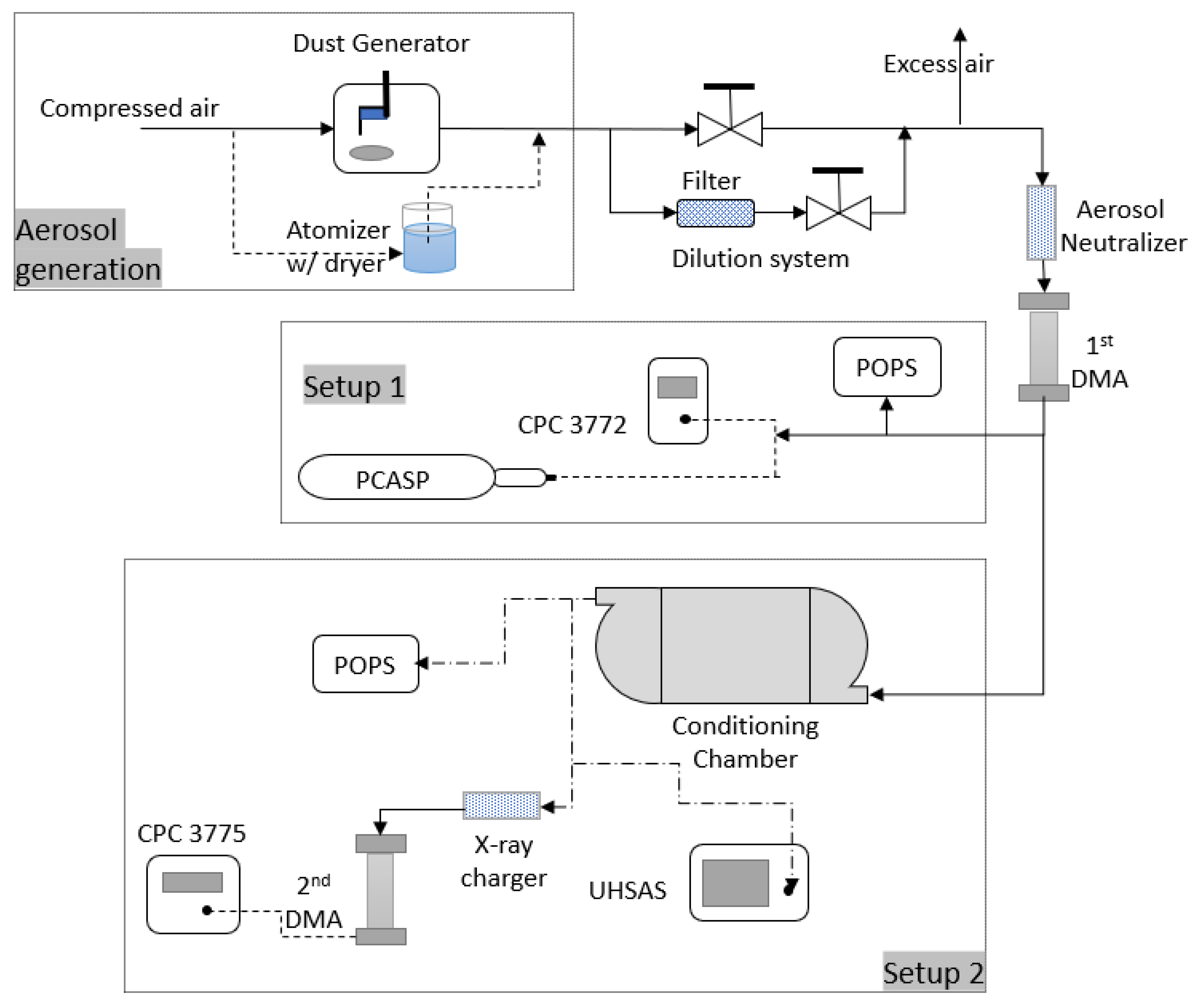
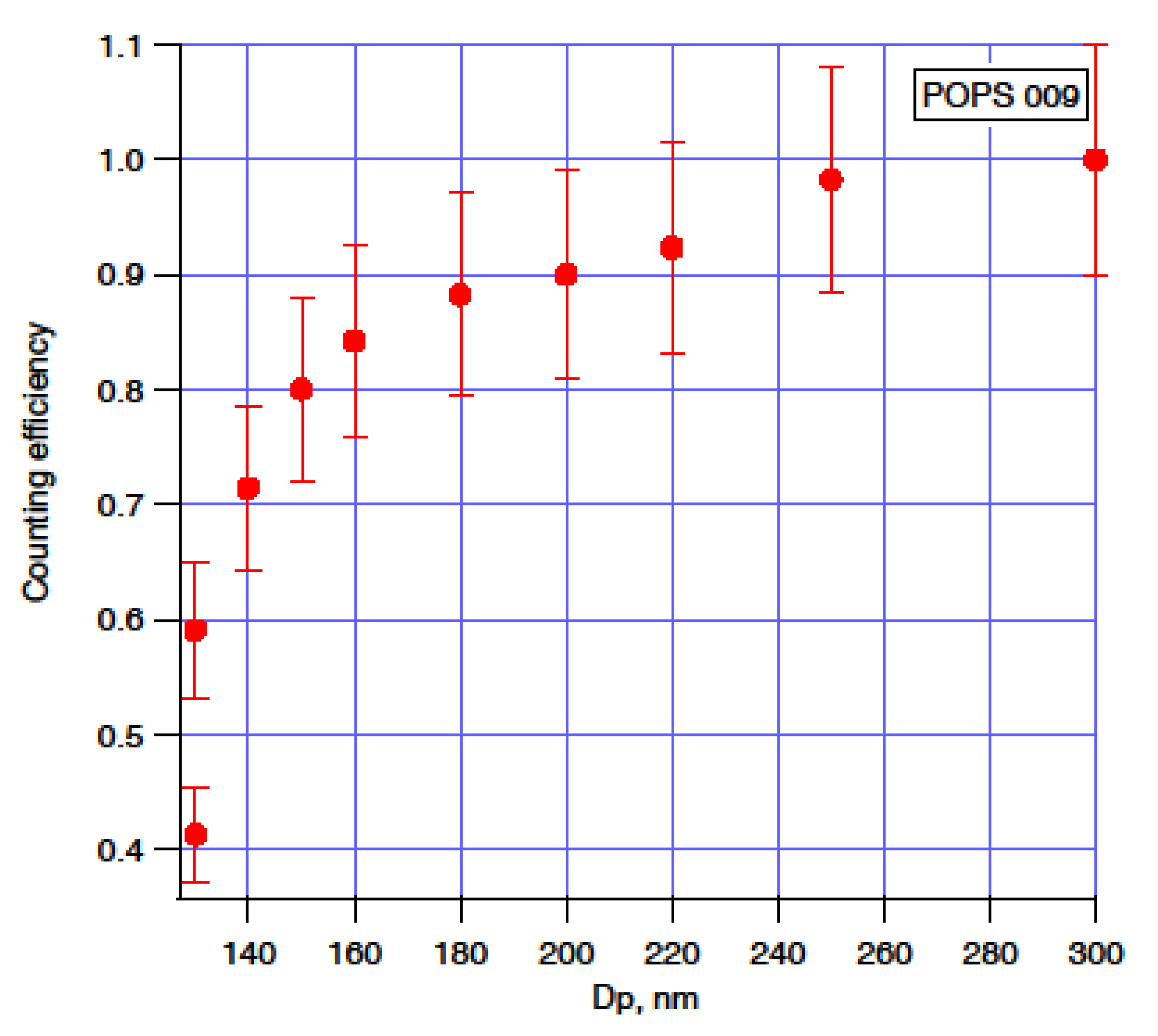
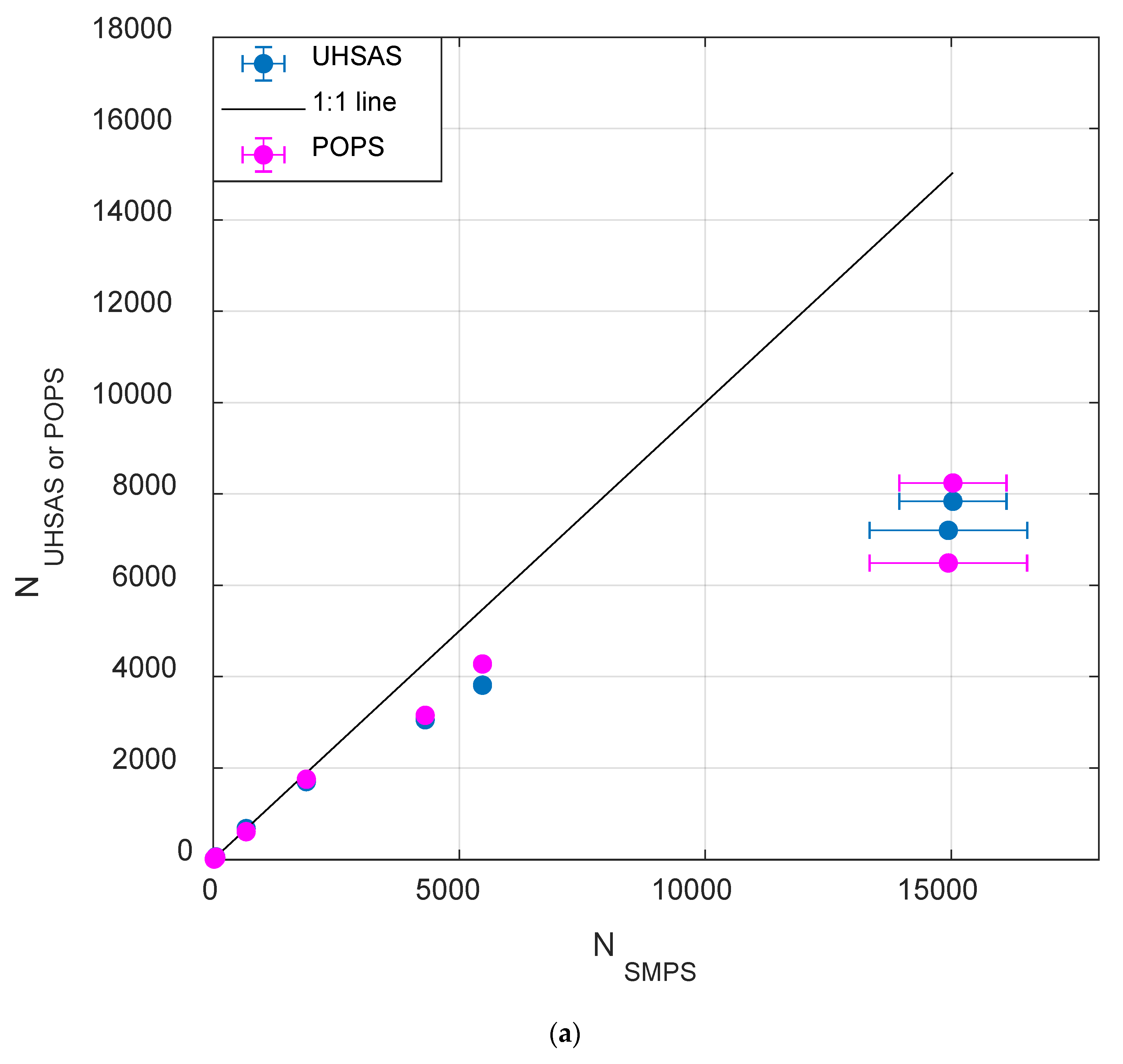
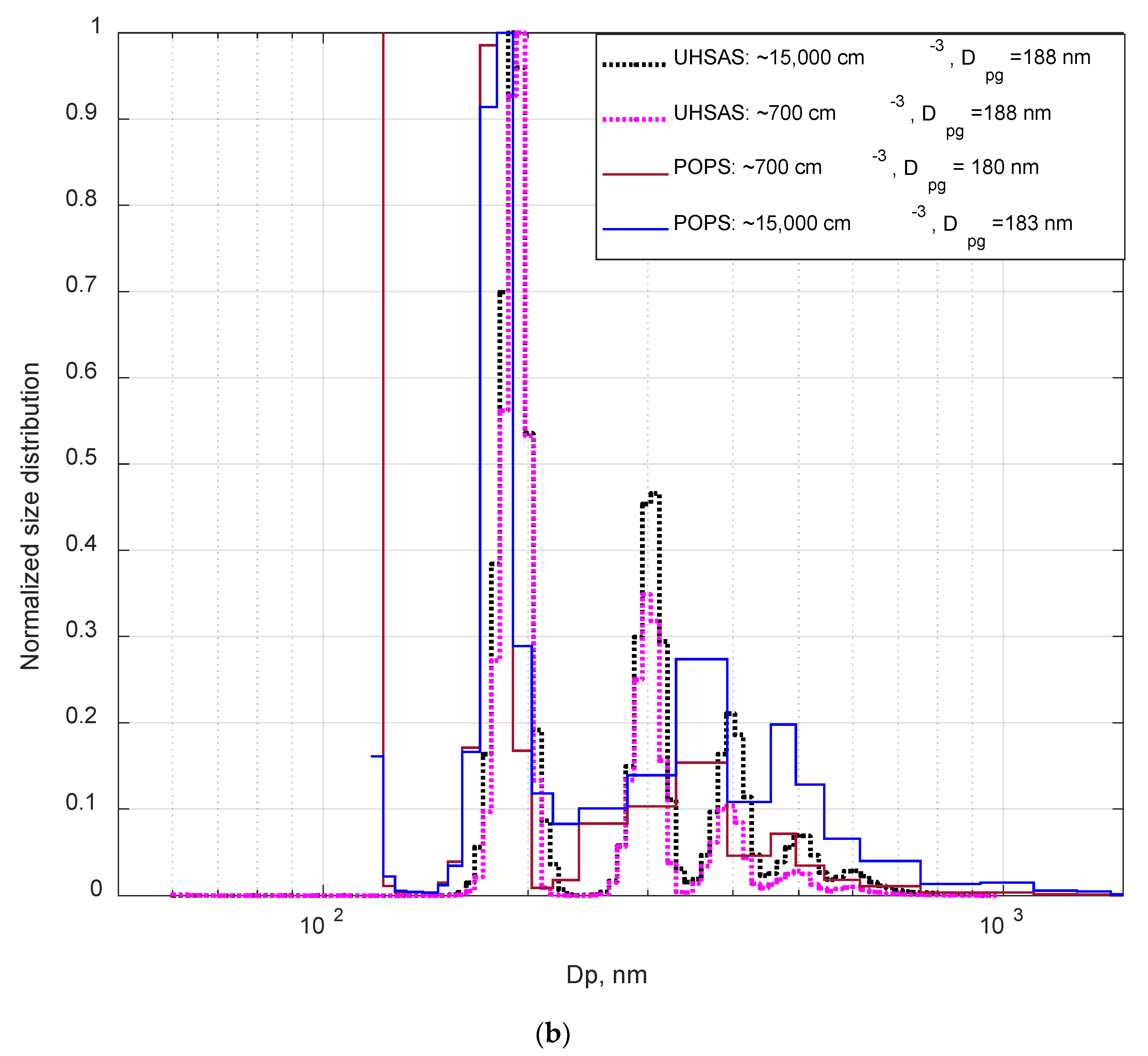
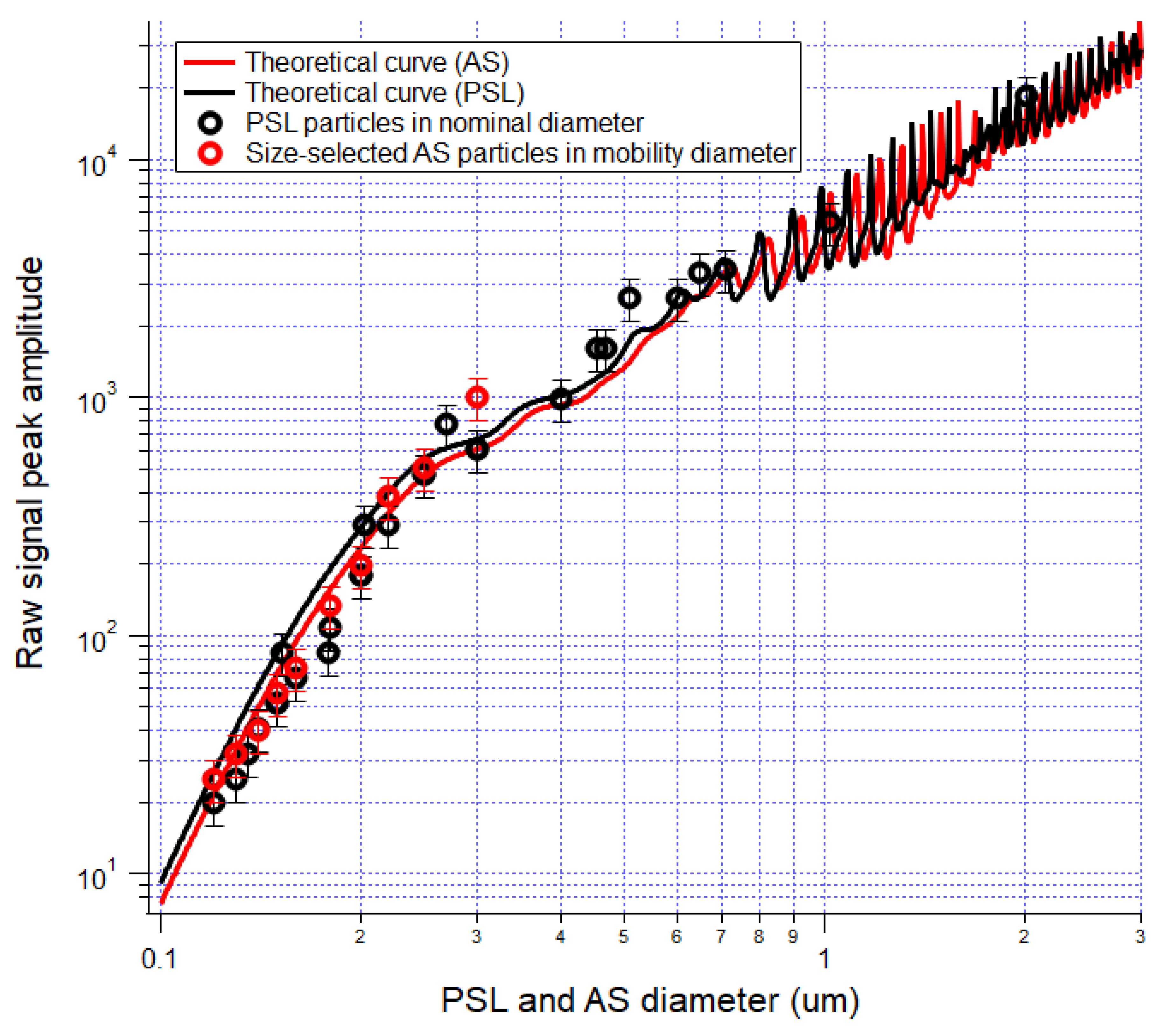

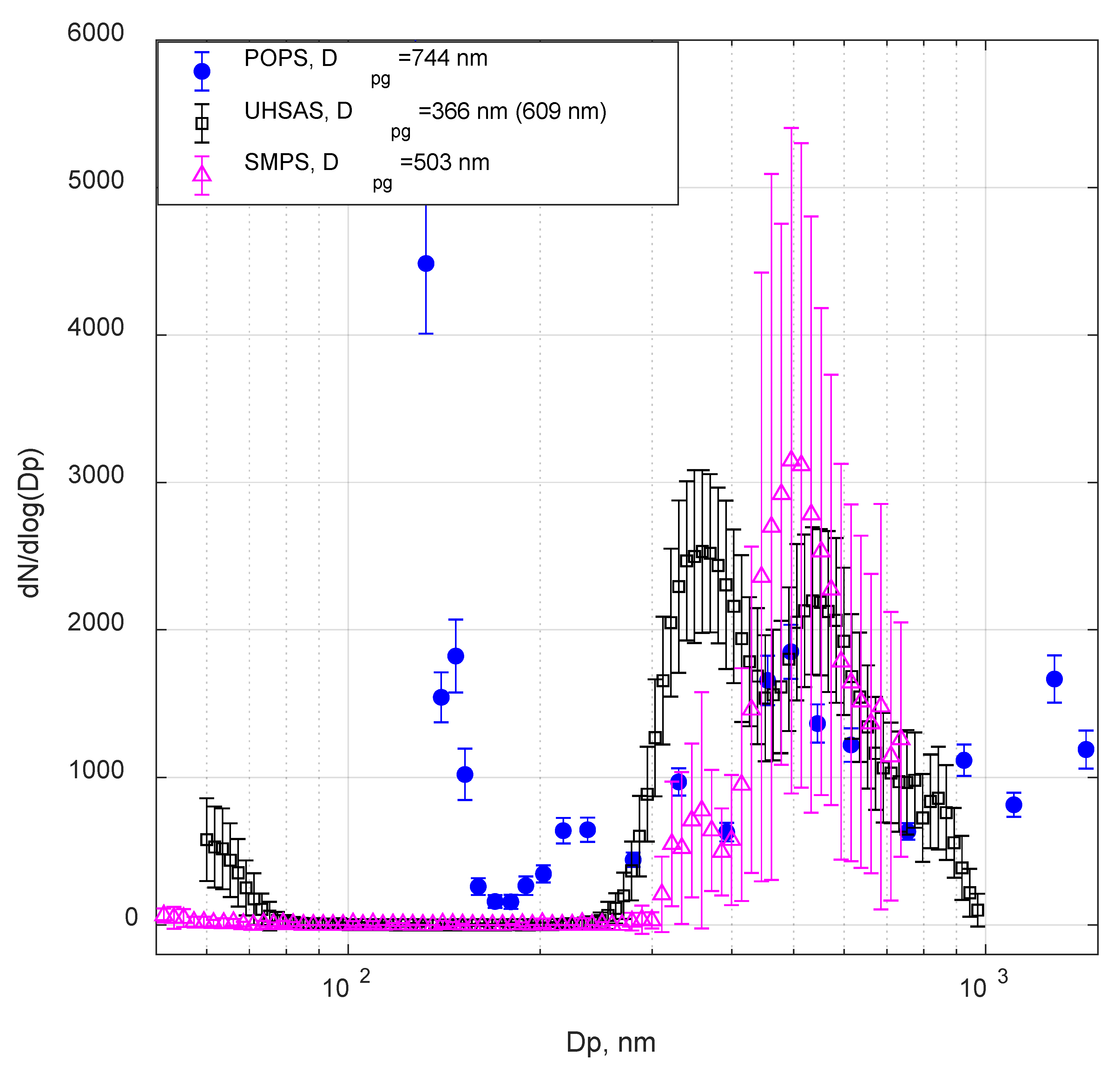
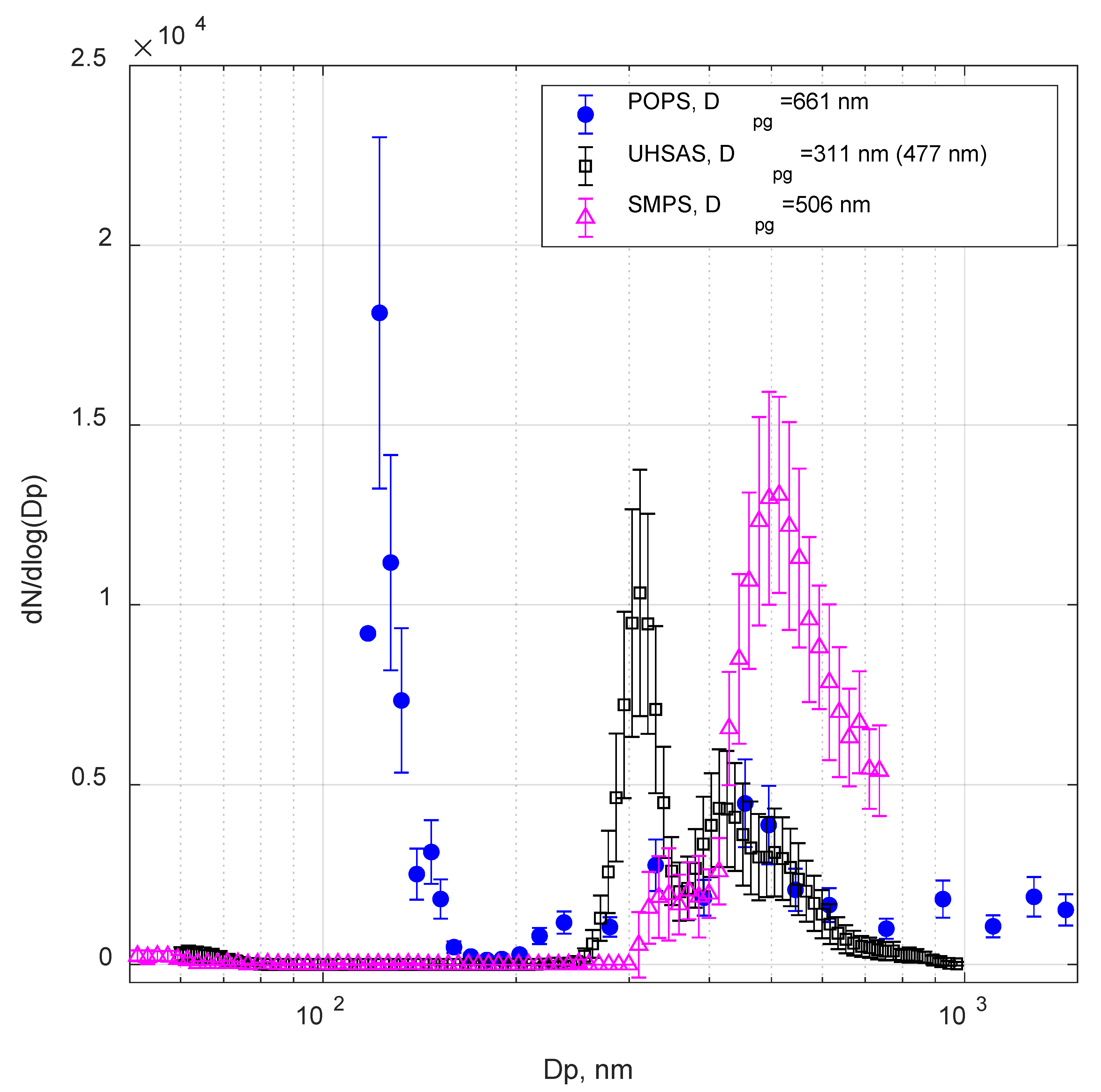

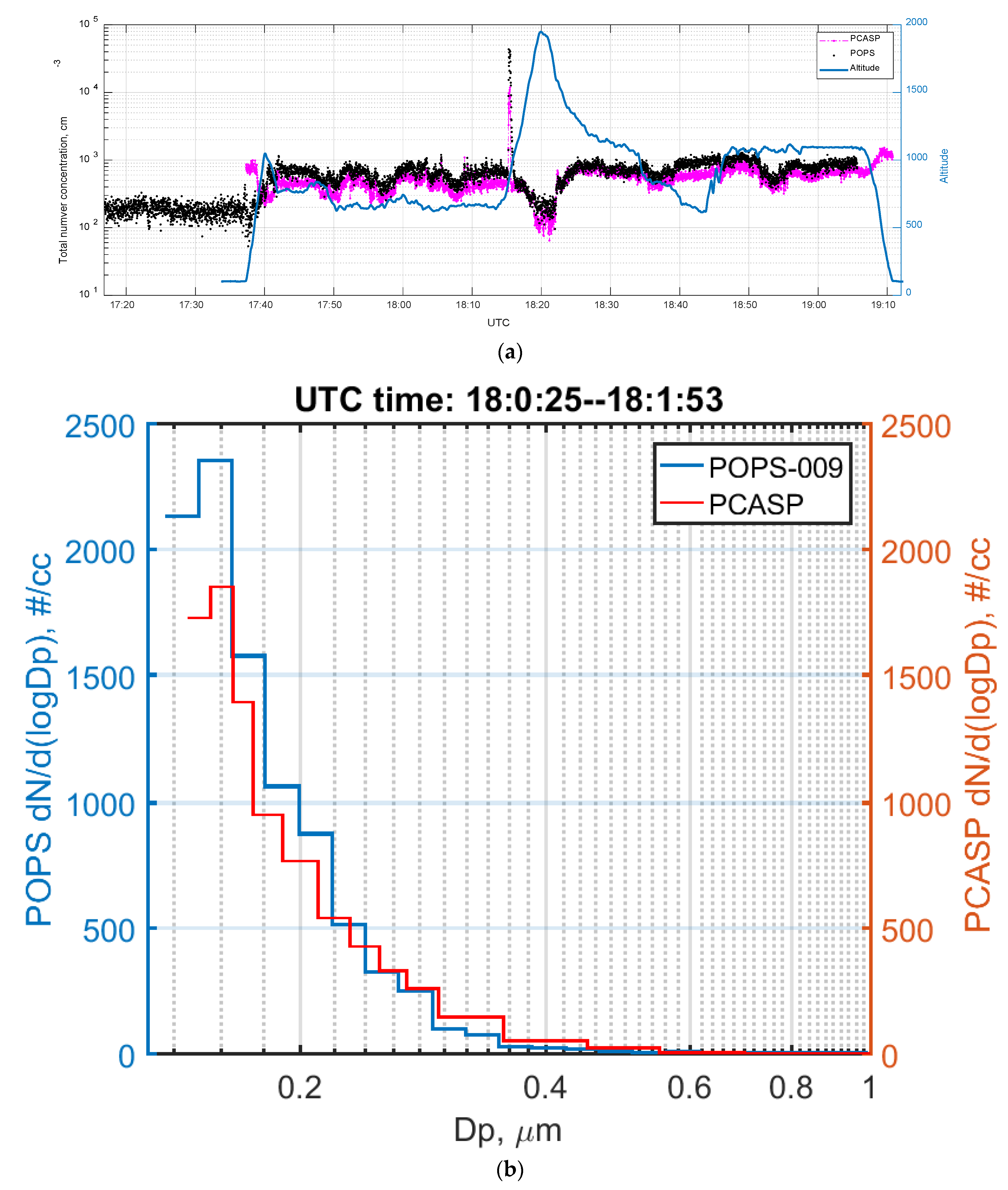
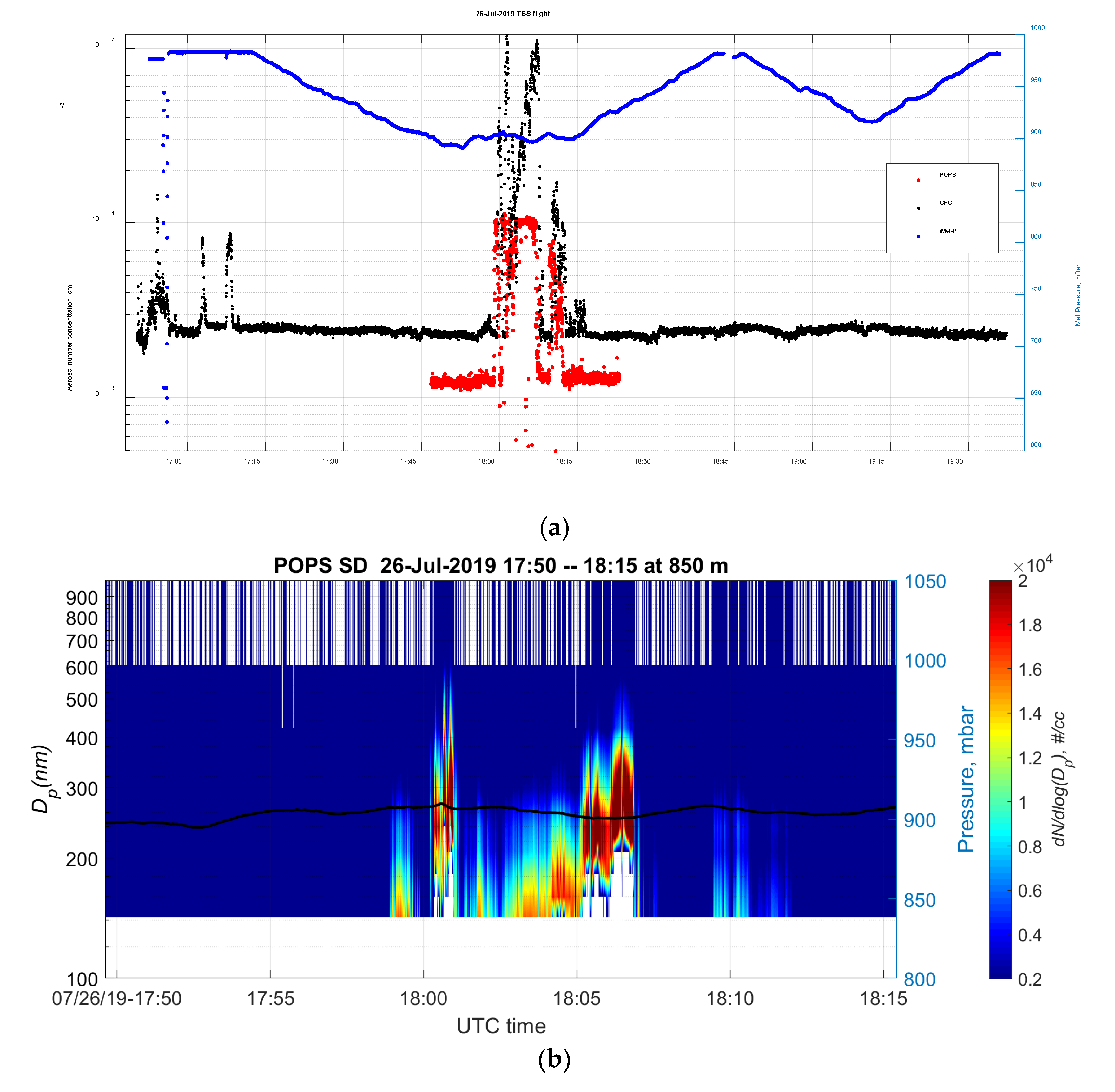
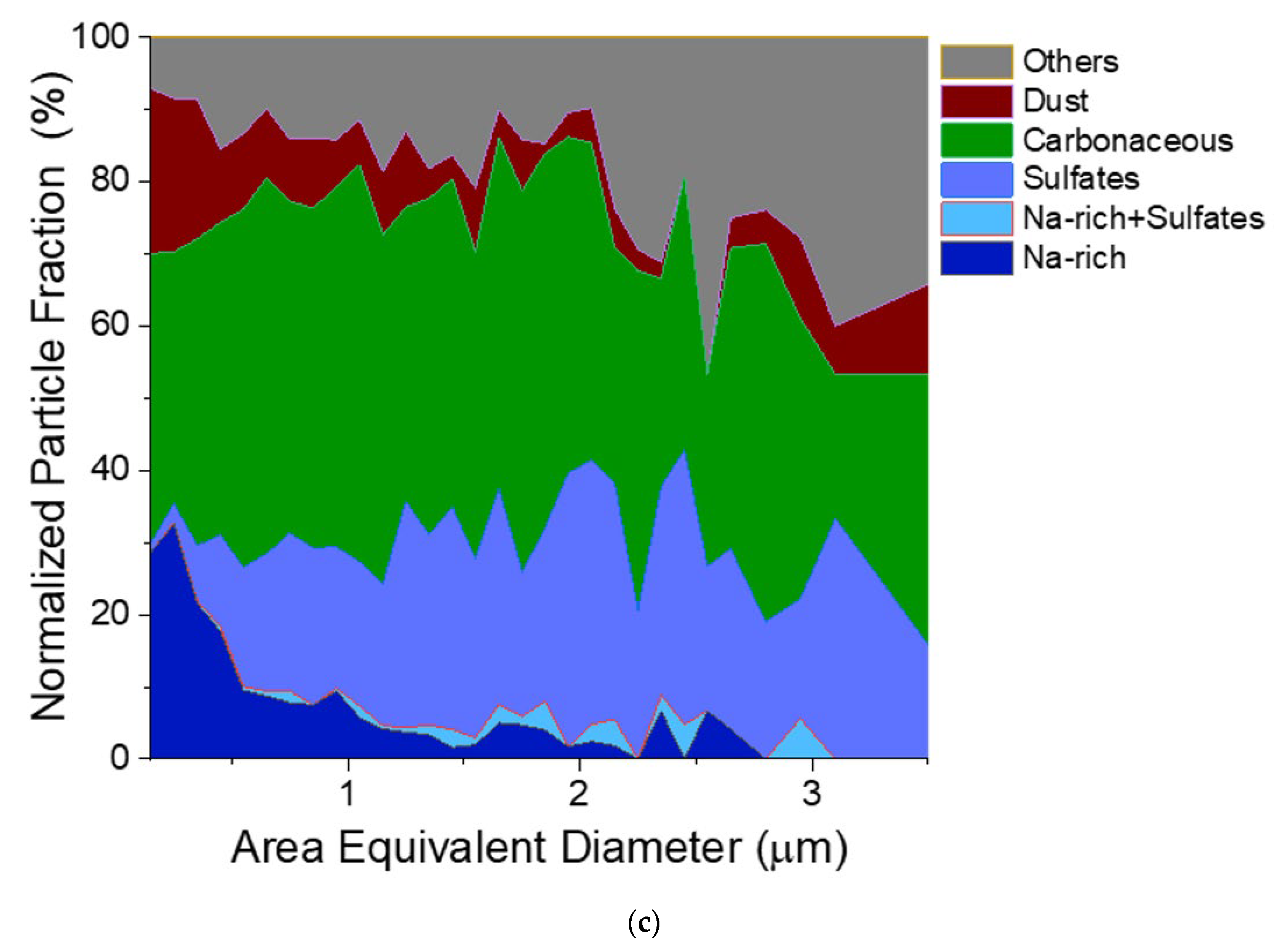
| Test Aerosol | Refractive Index at 405 nm | Morphology | Source | Reference |
|---|---|---|---|---|
| PSL | 1.63 + 0.001i | Spherical | Applied Physics. Inc. | [23] |
| Ammonium sulfate | 1.53 | Slightly non-spherical | Sigma-Aldrich | [24,25] |
| Arizona Test Dust | 1.51 + 0.00102i | Irregular | Powder Technology Inc. | [26,27] |
| Silicon dioxide | 1.4696 | Spherical | Sigma-Aldrich | [27,28] |
| Titanium dioxide | 2.682 | Aggregates of smaller size spheres | Aldrich | [29] |
Publisher’s Note: MDPI stays neutral with regard to jurisdictional claims in published maps and institutional affiliations. |
© 2020 by the authors. Licensee MDPI, Basel, Switzerland. This article is an open access article distributed under the terms and conditions of the Creative Commons Attribution (CC BY) license (http://creativecommons.org/licenses/by/4.0/).
Share and Cite
Mei, F.; McMeeking, G.; Pekour, M.; Gao, R.-S.; Kulkarni, G.; China, S.; Telg, H.; Dexheimer, D.; Tomlinson, J.; Schmid, B. Performance Assessment of Portable Optical Particle Spectrometer (POPS). Sensors 2020, 20, 6294. https://doi.org/10.3390/s20216294
Mei F, McMeeking G, Pekour M, Gao R-S, Kulkarni G, China S, Telg H, Dexheimer D, Tomlinson J, Schmid B. Performance Assessment of Portable Optical Particle Spectrometer (POPS). Sensors. 2020; 20(21):6294. https://doi.org/10.3390/s20216294
Chicago/Turabian StyleMei, Fan, Gavin McMeeking, Mikhail Pekour, Ru-Shan Gao, Gourihar Kulkarni, Swarup China, Hagen Telg, Darielle Dexheimer, Jason Tomlinson, and Beat Schmid. 2020. "Performance Assessment of Portable Optical Particle Spectrometer (POPS)" Sensors 20, no. 21: 6294. https://doi.org/10.3390/s20216294
APA StyleMei, F., McMeeking, G., Pekour, M., Gao, R.-S., Kulkarni, G., China, S., Telg, H., Dexheimer, D., Tomlinson, J., & Schmid, B. (2020). Performance Assessment of Portable Optical Particle Spectrometer (POPS). Sensors, 20(21), 6294. https://doi.org/10.3390/s20216294







